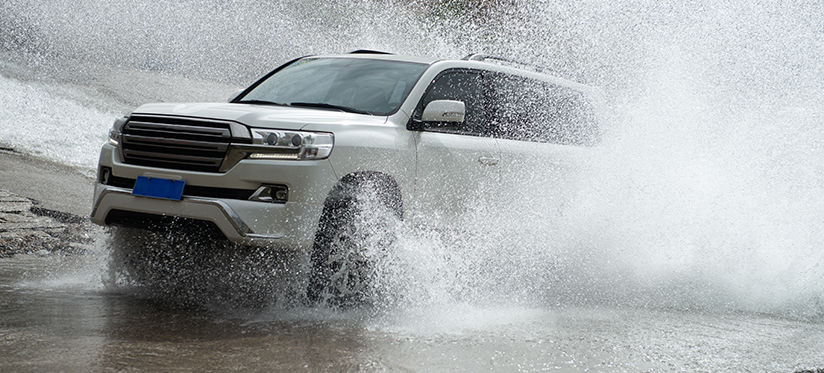
Driving in wet weather conditions can present a variety of challenges, one of the most dangerous being hydroplaning. This phenomenon occurs when a layer of water builds up between the tyres of a vehicle and the road surface, causing a loss of traction and control. Hydroplaning can be a frightening experience for drivers, but there are several proactive steps you can take to avoid it altogether. In this guide, we'll explore what hydroplaning is, its causes, and most importantly, how you can prevent it to stay safe on the road.
Understanding Hydroplaning
What is Hydroplaning?
Hydroplaning, also known as aquaplaning, happens when water on the road accumulates faster than a tyre's ability to disperse it. This creates a thin film of water between the tyre and the road surface, leading to a loss of traction and steering control.
Causes of Hydroplaning
Excessive Speed: Driving too fast for wet conditions increases the risk of hydroplaning as tyres are unable to channel water away quickly enough.
Worn Tread: Tyres with worn-out treads have reduced ability to disperse water, leading to an increased likelihood of hydroplaning.
Depth of Water: Standing water on the road, especially in areas of poor drainage, can create the conditions for hydroplaning.
Tyre Pressure: Underinflated tyres can deform more easily, reducing their ability to maintain contact with the road surface.
Vehicle Weight and Size: Heavier vehicles are more prone to hydroplaning as they require more time to disperse water from under the tyres.
How to Avoid Hydroplaning?
1. Maintain Proper Tyre Tread:
Ensure your tyres have adequate tread depth, as worn-out tyres are more susceptible to hydroplaning.
The minimum legal tread depth is typically 2/32 of an inch (1.6 mm), but for wet conditions, deeper tread is recommended.
2. Check Tyre Pressure Regularly:
Properly inflated tyres maintain their shape and provide better contact with the road surface.
Refer to your vehicle's owner's manual or the placard inside the driver's door for the recommended tyre pressure.
Read More: Things You Need To Know About Car Tyre Pressure
3. Reduce Speed in Wet Conditions:
Slowing down is one of the most effective ways to prevent hydroplaning.
Drive at a speed appropriate for the road conditions, especially during heavy rain, standing water, or after a downpour.
4. Avoid Sudden Braking or Acceleration:
Abrupt braking or acceleration can break the traction of the tyres and increase the risk of hydroplaning.
Apply gentle pressure on the brakes and accelerator to maintain control.
5. Drive in the Tracks of Other Vehicles:
Following the tracks of vehicles ahead can help displace water from the road surface.
However, be cautious of following too closely or losing visibility in the spray from other vehicles.
6. Use Quality Tyres Designed for Wet Conditions:
Consider investing in tyres specifically designed for wet weather performance.
Tyres with deeper grooves, sipes, and specialized tread patterns can enhance water dispersion and traction.
7. Avoid Cruise Control:
Disengage cruise control in wet conditions, as it may not respond quickly enough to changes in traction.
Manual control allows you to adjust your speed and braking as needed.
8. Keep a Safe Following Distance:
Maintain a safe distance between your vehicle and the one ahead to allow for ample reaction time.
This distance should be increased in wet conditions to accommodate longer braking distances.
9. Stay Alert and Focused:
Pay close attention to the road conditions, especially during heavy rain or after a storm.
Avoid distractions and keep both hands on the wheel, ready to respond to changing conditions.
What to Do If You Begin to Hydroplane?
Despite best efforts to prevent hydroplaning, it can still occur, especially in severe weather conditions. If you find yourself hydroplaning, follow these steps to regain control:
Remain Calm:
Stay calm and avoid sudden movements or panic.
Ease Off the Accelerator:
Gently release the accelerator to reduce speed.
Do Not Brake Abruptly:
Avoid slamming on the brakes, as this can cause loss of control.
Steer Straight:
Keep the steering wheel steady and straight to maintain direction.
Let Off the Gas:
Allow the vehicle to slow down naturally as you regain traction.
Avoid Overcorrecting:
Do not oversteer or make sudden movements, as this can worsen the situation.
Wait for Traction:
Once you feel the tyres grip the road again, gently accelerate to regain speed.
In Conclusion
Hydroplaning is a serious safety concern that can occur unexpectedly in wet weather conditions. By understanding its causes and taking proactive steps to prevent it, you can reduce the risk of hydroplaning and stay safe on the road.
Remember to maintain proper tyre tread, check tyre pressure regularly, reduce speed in wet conditions, and drive with caution. In the event that hydroplaning does occur, stay calm, ease off the accelerator, and steer straight until traction is regained.
With these precautions and safe driving practices, you can navigate wet roads confidently and avoid the dangers of hydroplaning. Prioritize safety, stay alert, and adjust your driving habits to match the conditions, ensuring a safe and enjoyable journey for you and your passengers.

